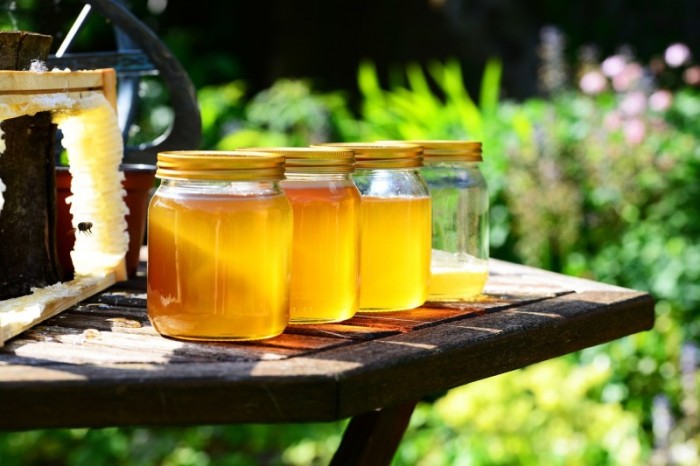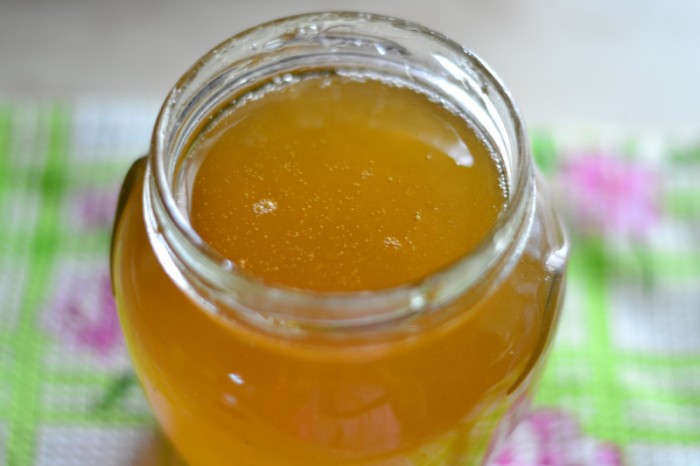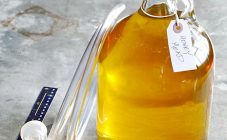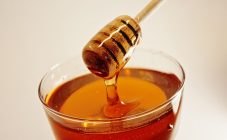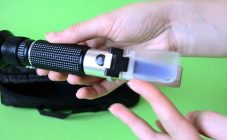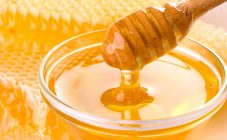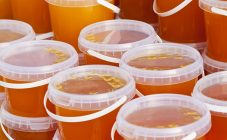Content:
People have used the unique properties of honey for their health since antiquity. First - as a delicacy, and then as a medicine. Of course, if we are talking about natural bee honey without the use of sugar and other additives.
Diastase number of honey: what is it
Diastase of honey, or otherwise enzymatic activity is an indicator of the ability of enzymes to break down starch, which determines the naturalness and degree of "maturity" of the product.
Bees collect nectar from flowers into their goiter, then “load” it into wax cells and repeatedly saturate the flower juice with enzymes produced from the throat and saliva. These enzymes are living biological components, with the help of which the nectar is "preserved" in the combs. They are classified into peroxidase, catalase, invertase and diastase, subdivided into alpha-amylase and beta-amylase.
The quality of honey is determined by the number of diastase enzymes. It shows the amount and activity of alpha-amylase and beta-amylase per unit volume and is equal to the number of milliliters of one percent starch solution that can be broken down by diastase enzymes in 1 gram of honey in 1 hour.
If there are few enzymes, then the diastasis of honey is low, but a lot - it means that the insects tried to ferment the collection and provide themselves with reserves for the winter.
What is measured
All necessary measurements should be made according to the instructions of GOST R 54386-2011 “Med. methods for determining the activity of sucrase, diastase number, insoluble matter ”. This standard applies to honey and establishes:
- method for determining the diastasis number in the measurement range from 3.0 to 40.0 units. Gothe;
- method for determining the diastasis number according to Shade in the measurement range from 0 to 40.0 units. Shade;
- method for determining the diastasis number according to Fadebaz in the measurement range from 0 to 40.0 units. Shade;
Back in 1914 in France, researcher Gothe found a way to determine the diastase number of honey. The unit was named after him. This method, in general, is still used, as the most convenient for calculating the diastatic number.
How to determine the diastatic number of honey
The presence and amount of diastase is easier to measure than other enzymes, so this analysis is done in laboratories. Only in the laboratory is it possible to accurately determine the diastase number both by the Gothe method and by the Sade or Fodebase methods.
But there is a method close to the laboratory (according to Gotha), to do this outside the laboratory at home you need:
- Place 4.5 ml of 10% honey solution in a flask,
- 5.5 ml distilled water
- 0.5 ml 0.58% salt solution
- 5 ml of 1% starch solution.
Cork tightly with a lid, mix and hold in a water bath at +40 degrees. After 1 hour, cool the tube to medium temperature. Then add 1-2 drops of iodine and stir again.
The color is transparent, or light yellow, will show that the diastase number of the tested honey is not less than 11.1 units. Gothe. This means that the product is fresh, natural, it can still be stored and used. If, with these proportions of the remaining ingredients of honey, take 2.2 ml and the same result will be obtained, then the diastase number is more than 22.2 units. Gothe.
What does the diastase of honey depend on, and what is it?
The diastase enzyme is found in all animals, it is necessary for the decomposition of starch and converting it into maltose to improve digestion. By the saturation of honey with enzymes, the degree of its biological activity is assessed.
The most important thing for insects is to stock up on food for the winter. In regions with short and warm winters, insects do not require a large amount of enzymes. Therefore, the diastase number of southern honey is 5-9 units. Gothe; sometimes the diastasis number of acacia honey approached zero. Altai and Bashkir honey - about 30 units; in Siberia and northern regions - 25-45 and more units. Gothe.
The permissible limits of the number are set from 5 to 50 units of Gothe. Low indicators indicate impurities of water, sugar, juice, sugar molasses, starch, gelatin, chalk, food flavorings. Or it is overheated, which greatly reduces the activity of enzymes and medicinal properties. Long (3 or more years) and improper storage also reduces enzymatic activity every year by 20-25%.
Therefore, it is necessary to store at temperatures from 0 to 10 degrees only in enamel, ceramic or glassware. Reactions occur with aluminum, copper and zinc, in which poisonous compounds are formed. If spilled in a retail container, there is a risk of losing diastase enzymes altogether. It turns out to be a common delicacy.
A certain type of honey has an individual diastasis number. Climate, harvest time, honey varieties, bee breeds, storage conditions, heat treatment - these factors reduce or increase the indicator. During the checks, it was found that:
- linden honey contains a small number - 11.5-20 units. Gothe;
- sainfoin - up to 14.6 units;
- buckwheat - up to 60 units;
- white acacia - 6.3-7 units;
- sunflower -17.8-19 units;
- sweet clover - 20.4-21.5 units;
- heather - 27.9-29 units;
- meadow clover - 9.6-11 units
Northern honey lasts longer. The more numerous and stronger the family of bees, the higher the diastasis number, because more enzymes are introduced into the flower juice than by weak insects. Strong bees from the same field will give about 50 units of Gotha; and the weak - about 10 units.
There is a version that insects themselves "know how" to calculate how much starch is in the nectar and bring in diastase exactly necessary in order to completely decompose it. Because starch in nectar is bad food for bees, therefore, nature has endowed them with the ability to correct this situation.
Diastasis numbers are more than 55-60 units. Gothe speaks about the presence of additives or water, which leads to fermentation, acidification of the biological product. We can no longer talk about the benefits and use.
Range of diastasis numbers by region
| Region and region names | Diastatic number units Gothe |
| Amurskaya | 5,0 |
| Altai region | 10,0 |
| Bashkir | 10,0 |
| Belgorodskaya | 18,0 |
| Bryansk | 14,0 |
| Buryatia | 18,7 |
| Vladimirskaya | 11,0 |
| Vologda | 10,0 |
| Volgograd | 10,0 |
| Voronezh | 12,0 |
| Nizhny Novgorod | 8,0 |
| Dagestan | 10,0 |
| Ivanovskaya | 6,0 |
| Irkutsk | 16,0 |
| Kabardino-Balkaria | 10,0 |
| Kaluga | 16,0 |
| Kaliningrad | 17,0 |
| Kalmyk | 6,4 |
| Karelian | 15,0 |
| Kemerovo | 17,0 |
| Kostroma | 10,0 |
| Kirovskaya | 12,9 |
| Sverdlovsk | 14,4-31,8 |
| North Ossetia | 14,6 |
| Smolensk | 20,0 |
| Stavropol region | 13,7 |
| Tambov | 10,0 |
| Tomsk | 23,0 |
| Tula | 18,0 |
| Tyumen | 19,0 |
| Udmurtia | 12,0 |
| Ulyanovsk | 6,4 |
| Khabarovsk region | 8,3 |
| Chelyabinsk | 10,5 |
| Ingushetia | 6,0 |
| Chitinskaya | 10,0 |
| Chuvash region | 5,0 |
| Krasnoyarsk region | 6,4 |
| Kurgan | 10,8 |
| Leningradskaya | 10,8 |
| Mari Aut. district | 6,5 |
| Mordovia | 10,8 |
| Moscow | 17,9 |
| Omsk | 10,0 |
| Novosibirsk | 8,0 |
| Orenburg | 10,0 |
| Orlovskaya | 13,0 |
| Penza | 18,7 |
| Perm | 10,0 |
| Primorsky Krai | 8,3 |
| Pskov | 10,2 |
| Rostov | 17,9 |
| Ryazan | 10,0 |
| Saratov | 1,1-4,4 |
| Lipetsk | 1,1-4,4 |
| Bashkiria | 14,4-31,8 |
| Sakhalin | 14,0 |
| Kyrgyzstan | 20,0-30,7 |
| Odessa | 6,8-8,7 |
| Donetsk | 6,8-8,7 |
| Pavlodar | 9,0 |
| Kazakhstan | 10,0 |
| Belarus | 10,0 |
| Baltics | 5,0-10,0 |
| Moldavia | 10,8 |
| Tajikistan | 12,8 |
| Armenia | 10,8 |
| Turkmenistan | 6,5 |
In conclusion, it is impossible to confidently assert that the number of diastases is evidence of the high quality and good medicinal properties of bee collection. Diastase of honey only shows that it is a natural product, fresh, without impurities, properly stored and suitable for consumption.

